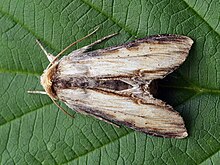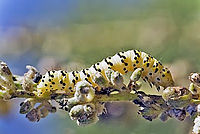Shargacucullia lychnitis, the striped lychnis is a moth of the family Noctuidae. It is found throughout most parts of Europe the Near East and Middle East (Lebanon, Israel, Afghanistan, Iran, Turkmenistan and Iraq).
| Shargacucullia lychnitis | |
|---|---|

| |
| Scientific classification | |
| Domain: | Eukaryota |
| Kingdom: | Animalia |
| Phylum: | Arthropoda |
| Class: | Insecta |
| Order: | Lepidoptera |
| Superfamily: | Noctuoidea |
| Family: | Noctuidae |
| Genus: | Shargacucullia |
| Species: | S. lychnitis
|
| Binomial name | |
| Shargacucullia lychnitis (Rambur, 1833)
| |
| Synonyms | |
| |

Technical description and variation
editC. lychnitis Rmb. (27 g). Forewing narrow, pale ochreous with a more rufous tinge than in thapsiphaga [Shargacucullia thapsiphaga (Treitschke, 1826) ], the costal streak darker; hindwing in both sexes whitish, the terminal shade narrower in the male. Larva greenish white with a pale yellow band on each segment; a dorsal row of curved black bars alternating with rows of 4 black spots; a row of black spots along the sides.[1] The wingspan is 42–47 mm.
Biology
editAdults are on wing from February to April in the eastern parts of its range. In Britain it is on wing from June to July. There is one generation per year.
The larvae feed on the leaves and flowers of Verbascum species (including Verbascum lychnitis, Verbascum nigrum and Verbascum austriacum).
Subspecies
edit- Shargacucullia lychnitis lychnitis
- Shargacucullia lychnitis albicans (eastern part of the range)
Similar species
editShargacucullia lychnitis is difficult to certainly distinguish from these congeners. See Townsend et al.[2]
- Shargacucullia scrophulariae ([Denis & Schiffermüller], 1775)
- Shargacucullia verbasci (Linnaeus, 1758)
References
edit- ^ Warren. W. in Seitz, A. Ed., 1914 Die Großschmetterlinge der Erde, Verlag Alfred Kernen, Stuttgart Band 3: Abt. 1, Die Großschmetterlinge des palaearktischen Faunengebietes, Die palaearktischen eulenartigen Nachtfalter, 1914 This article incorporates text from this source, which is in the public domain.
- ^ Martin C. Townsend, Jon Clifton and Brian Goodey (2010). British and Irish Moths: An Illustrated Guide to Selected Difficult Species. (covering the use of genitalia characters and other features) Butterfly Conservation.
External links
edit